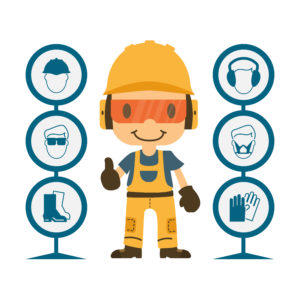Personal protective equipment (PPE) plays a vital role in worker health and safety, and employers have a legal duty to provide it under the Personal Protective Equipment at Work Regulations 1992. PPE includes any item worn by an employee to mitigate risks to their health and safety, and may include helmets, gloves, eye protection, high-visibility clothing, safety footwear, safety harnesses, and respiratory protective equipment (RPE) .
The vital role of PPE in worker safety
It is the legal duty of your employer to provide the necessary safety equipment to enable you to undertake your job in safety. PPE plays a major role in making this happen and may be used in a wide variety of occupational contexts. PPE can offer protection to any part of the body, such as:
- Eyes – by preventing flying debris or splashes of corrosive liquids

- Head – a hard hat can reduce the damage caused by falling materials
- Feet – steel capped shoes can protect the feet from falling objects
- Lungs – respiratory PPE can prevent the inhalation of contaminated air
- Whole body – suitable clothing can protect from extremes of heat or cold
- Skin – PPE can offer protection when working with corrosive materials
PPE alone is not enough
While PPE is important, it should only be used where a risk assessment has identified a specific health and safety hazard which cannot be fully removed by other means. For example, it would not be acceptable for an employer to state they controlled the risk of objects falling from height in a warehouse by providing hard hats; proper methods should be used such as pallet wrapping, strict management of shelf weight limits, and physical barriers or nets to prevent objects falling.
Where PPE is needed, it is also vital that employees are given the necessary instruction and training in its use. They need to know it is not optional, no matter how long the worker is in the area of identified risk, after all, it only takes seconds for a serious accident to happen. They also need to understand how to fit the PPE properly, so it is worn in the manner it was designed to be, and also within its limitations (i.e. temperatures, weights and dimensions). Signage should also be in place in the area of risk to remind everyone of the need to wear PPE.
Has your employer selected the correct PPE?
Your employer must purchase PPE which conforms to the CE standard and the Personal Protective Equipment Regulations 2002. One factor that must be taken into consideration is compatibility. In many workplace situations, an employee may need to wear several items of safety equipment, and therefore one cannot conflict or prevent the use of another. For example, if a hard hat or respirator and eye protection must be worn together, are they compatible? And if an employee normally wears glasses to correct their vision, will the PPE provided fit correctly?
Another important factor is the fit of the protective equipment. The PPE provided must meet the varying dimensions and weights of all staff members. Failure to check this may constitute a breach of health and safety law, and in addition may in some contexts increase the risk to the worker, for example, if an item of protective clothing is too large, excess material can become trapped in machinery.
PPE must offer the intended type and amount of protection, and must not inhibit the role being undertaken, e.g. if a facemask is needed, can the employee still communicate with their colleagues?
The ongoing obligations around PPE
Once the risk assessments are completed and PPE is in place, with the necessary instruction and signage, employers still need to undertake regular monitoring of the equipment, for a number of reasons:
- To be refilled (as in the case of earplugs)
- Checking for damage
- Regular maintenance
- Replacement once the PPE no longer meets safety standards, or needs to be retired
- Ensuring employees are conforming to the PPE rules (the importance of PPE should be constantly reiterated to all workers).
- If the task changes, additional or alternative PPE may be needed
If I have been injured at work due to lack of PPE, can I make a claim for compensation?
For anyone seriously injured at work whereby either PPE was not provided, did not provide the level of protection needed, did not fit properly, was in poor condition, did not work properly, was provided but there was no training or instruction provided, or any other such scenario, you may have the basis for a compensation claim against your employer for negligence. It will be necessary to establish that you fully carried out your obligations with respect to the PPE, in other words, you wore the PPE as per the guidance you were provided. If it can be found your employer failed in their duty to ensure your safety, you may be eligible for compensation – call our team today who will be able to advise you on the merits of your case and explain your options and next steps.
At Russell Worth Solicitors we specialise in personal injury claims. If you have suffered a workplace injury and would like a free claim assessment, please call us now on 0800 028 2060 or complete our Online Claim Assessment.

